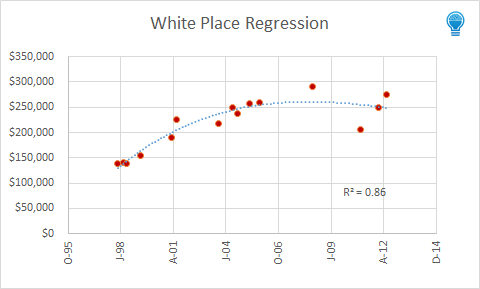Understanding Appreciation Rates [Analyze This]
by Osman Parvez
Most of my clients are buyers and sellers of primary or vacation homes, but they still care deeply about their home’s investment potential. Real estate is often the largest financial decision that most people make, it’s not surprising that we’ll sometimes delve into a bit of analysis.
Boulder condos appreciated 9.8% last year, on average (the median price increased 6%). What about your condo? How about that property you are seriously considering buying? Did it appreciate 6-10% last year?
The short answer is no. The long (real) answer is that it takes time and effort to understand appreciation rates for a specific property.
I recently put together an analysis for one of my buyers. He decided to pass on the investment, so I can now share the analysis with you. The goal is to better understand appreciation rates.
The condo in question is located on White Place in Boulder. It’s a 3 bedroom, 2 bath with about 1,200 SQFT. Most of the other condos in the complex have a similar layout.
These were the comparable sales at the complex.
When you do this sort of analysis, it’s important to pull comps from both the MLS and the tax assessor. It’s safe to assume that sales on the MLS are arms-length market transactions with similar transaction costs, but non MLS sales might be due to inheritance, family transfers, or divorce settlements. If the dollar amount is grossly out of line with other comps, it’s probably a non arms-length transaction and should be removed from the comps.
As you can see, there isn’t much turnover at this development (a good sign). Over the course of 15 years, there were only 15 market sales.
Matched Pairs Analysis
Four of the condos turned over more than once, which allows us to do a matched pairs analysis. Take a look.
Ignoring transaction costs and capital improvements, you can back into a rough annual appreciation rate based on these repeat sales. In this analysis, appreciation ranged from 1.9% to 10%. By the way, matched pairs is also how the Case-Shiller index is created.
The first two matched pairs show high rates of appreciation. A review of the listing photos and descriptions for 5405 White Place (link) and 5421 White Place (link) suggest some remodeling. These sales also occurred near the end of the last real estate cycle – good timing on the owners part.
Back of the Envelope Analysis
Ignoring transaction costs – especially remodeling costs – doesn’t yield a great analysis. Let’s make some educated guesses and create a back of the envelope analysis.
Take the purchase of a basic unit in 1998, such as 5425 White Place and assume the owner immediately spent $15,000 remodeling the unit (reasonable for 1998), a market value of $285,000 today would yield an Internal Rate of Return (IRR) of 4.1%.
This approach passes the sniff test. It’s rate greater than inflation, which is what you’d expect for Boulder, and it reflects a reasonable rate of appreciation during a longer period of time – i.e. a full real estate cycle.
Visualizing Appreciation
One way to visualize how the market changed for units at White Place is with a simple regression.
As you already know, regression is the best fit straight line through a series of data points, commonly referred to sum of the least squares. Well, maybe you don’t know that so here’s a link to more information. When I got started as an analyst, we actually had to do a few of these the old fashioned way – with a calculator and graph paper. Today, we have Excel.
The straight line approach returns an R2 of only .61. Not a particularly great fit.
With an R2 of .86, a third order polynomial regression first the data better and matches what we know of the last real estate cycle. You’ll note the higher rate of appreciation from 1998 to 2005, the last market upswing, and higher volume as the market began to peak.
From 2005 to 2012, the market more or less skidded sideways, with prices even dipping slightly. However for the last 18 months, the inventory shortage has begun pushing prices skyward. We may be entering another period more similar to the strong appreciation experienced from ’98 to ’05 (as high as 10%, excluding remodeling costs).
Shopping for real estate? My training and professional experience as an investment analyst is a competitive advantage I offer over other Realtors. Whether you’re looking for your dream home or an investment property, I can help you make a smarter real estate decision. ph: 303.746.6896.
—
Understanding Appreciation Rates [Analyze This]
by Osman Parvez
Most of my clients are buyers and sellers of primary or vacation homes, but they still care deeply about their home’s investment potential. Real estate is often the largest financial decision that most people make, it’s not surprising that we’ll sometimes delve into a bit of analysis.
Boulder condos appreciated 9.8% last year, on average (the median price increased 6%). What about your condo? How about that property you are seriously considering buying? Did it appreciate 6-10% last year?
The short answer is no. The long (real) answer is that it takes time and effort to understand appreciation rates for a specific property.
I recently put together an analysis for one of my buyers. He decided to pass on the investment, so I can now share the analysis with you. The goal is to better understand appreciation rates.
The condo in question is located on White Place in Boulder. It’s a 3 bedroom, 2 bath with about 1,200 SQFT. Most of the other condos in the complex have a similar layout.
These were the comparable sales at the complex.
When you do this sort of analysis, it’s important to pull comps from both the MLS and the tax assessor. It’s safe to assume that sales on the MLS are arms-length market transactions with similar transaction costs, but non MLS sales might be due to inheritance, family transfers, or divorce settlements. If the dollar amount is grossly out of line with other comps, it’s probably a non arms-length transaction and should be removed from the comps.
As you can see, there isn’t much turnover at this development (a good sign). Over the course of 15 years, there were only 15 market sales.
Matched Pairs Analysis
Four of the condos turned over more than once, which allows us to do a matched pairs analysis. Take a look.
Ignoring transaction costs and capital improvements, you can back into a rough annual appreciation rate based on these repeat sales. In this analysis, appreciation ranged from 1.9% to 10%. By the way, matched pairs is also how the Case-Shiller index is created.
The first two matched pairs show high rates of appreciation. A review of the listing photos and descriptions for 5405 White Place (link) and 5421 White Place (link) suggest some remodeling. These sales also occurred near the end of the last real estate cycle – good timing on the owners part.
Back of the Envelope Analysis
Ignoring transaction costs – especially remodeling costs – doesn’t yield a great analysis. Let’s make some educated guesses and create a back of the envelope analysis.
Take the purchase of a basic unit in 1998, such as 5425 White Place and assume the owner immediately spent $15,000 remodeling the unit (reasonable for 1998), a market value of $285,000 today would yield an Internal Rate of Return (IRR) of 4.1%.
This approach passes the sniff test. It’s rate greater than inflation, which is what you’d expect for Boulder, and it reflects a reasonable rate of appreciation during a longer period of time – i.e. a full real estate cycle.
Visualizing Appreciation
One way to visualize how the market changed for units at White Place is with a simple regression.
As you already know, regression is the best fit straight line through a series of data points, commonly referred to sum of the least squares. Well, maybe you don’t know that so here’s a link to more information. When I got started as an analyst, we actually had to do a few of these the old fashioned way – with a calculator and graph paper. Today, we have Excel.
The straight line approach returns an R2 of only .61. Not a particularly great fit.
With an R2 of .86, a third order polynomial regression first the data better and matches what we know of the last real estate cycle. You’ll note the higher rate of appreciation from 1998 to 2005, the last market upswing, and higher volume as the market began to peak.
From 2005 to 2012, the market more or less skidded sideways, with prices even dipping slightly. However for the last 18 months, the inventory shortage has begun pushing prices skyward. We may be entering another period more similar to the strong appreciation experienced from ’98 to ’05 (as high as 10%, excluding remodeling costs).
Shopping for real estate? My training and professional experience as an investment analyst is a competitive advantage I offer over other Realtors. Whether you’re looking for your dream home or an investment property, I can help you make a smarter real estate decision. ph: 303.746.6896.
—
Share This Listing!
More about the author
Osman Parvez
Owner & Broker at House Einstein as well as primary author of the House Einstein blog with over 1,200 published articles about Boulder real estate. His work has appeared in the Wall Street Journal and Daily Camera.
Osman is the primary author of the House Einstein blog with over 1,200 published articles about Boulder real estate. His work has also appeared in many other blogs about Boulder as well as mainstream newspapers, including the Wall Street Journal and Daily Camera. Learn more about Osman.
Work with
House Einstein
Thinking about buying or selling and want professional advice?
Call us at 303.746.6896
Your referrals are deeply appreciated.



















